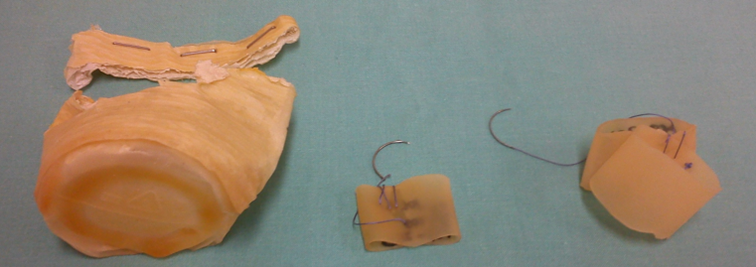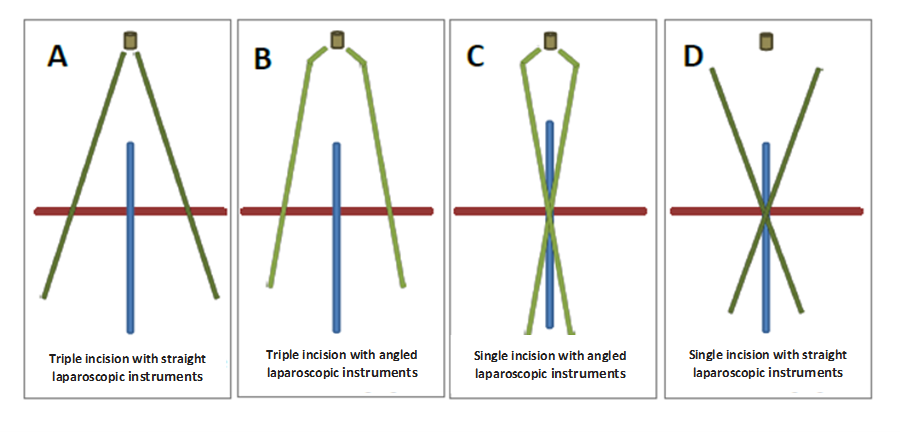Leipzig endoscopic surgical skill assessment data set for pediatric interventions The Leipzig endoscopic training data set for pediatric surgery is an annotated video data set, which includes also surgical activity recordings [1]. The workflows were obtained by observer-based recording using the methods described in [2] and the Surgical Workflow Editor [3]. The data set was recorded during pediatric minimally invasive surgical training sessions in the Department of Pediatric Surgery of the University Medical Center Leipzig during 2009-2011. The Pelvitrainer [4] (Figure 1), which represented the abdomen and silicone manikins were used, which represent different anatomical structures, like stomach and intestinal (Figure 2).

Figure 1 – Pelvitrainer and study set up [4]

Figure 2 – Silicone manikins for different tasks: cut, simple suturing and complex suturing [1]
he study consisted of two subject groups with five novices (medical students without endoscopic experience) and five experts (surgeons with advanced endoscopic experience). Each participant performed three different tasks:
- Cutting (ablation of a 1cm stripe at the top of the phantom)
- Simple suturing (sewing a tubular phantom with four stiches)
- Complex suturing (anastomosis, joining two pieces of tubular phantoms with four stiches)
In addition, different surgical strategies were analyzed, which includes variations of applying different instrument types and incision points (Figure 3):
- Triple incision with straight laparoscopic instruments
- Triple incision with angled laparoscopic instruments
- Single incision with angled laparoscopic instruments
- Single incision with straight laparoscopic instruments

Figure 3 – Surgical strategies [1]
The participants performed each of the tasks and each surgical strategy five times. Therefore, the evaluation data set consists of approximately 600 workflows in total.
The LESSON data set includes different components:
- Video data: video captured from endoscopic camera and video capturing the participant while performing the task
- Manual workflow record (XML-file): For workflow recording, a finite set of motions, instruments and treated structures was used.
The recorded data include:
- Start time, stop time and duration of activities
- Actor and the used body part (left or right hand)
- Actions/motions
- Used Instruments
- Treated structures
- Sequential and temporal order of the activities
Referencing Guidelines
If you use LESSON for any research project submitted for publication, cite the following paper in your manuscript as a reference source:
S. Schumann, U. Bühligen, und T. Neumuth, „Distance Measures for Surgical Process Models“, Methods Inf. Med., Bd. 52, Nr. 5, S. 422–431, Aug. 2013.
Please also cite this website and the version of the dataset, which was used for the corresponding work.
Acknowledgements
We thank Dr. Sandra Schumann for the generation of this data set and Prof. Dr. Holger Till, Prof. Dr. med. Ulf Bühligen and also all participants from Department of Pediatric Surgery at the University Medical Center Leipzig for their support.
Literature
[1] S. Schumann, U. Bühligen, und T. Neumuth, „Distance Measures for Surgical Process Models“, Methods Inf. Med., Bd. 52, Nr. 5, S. 422–431, Aug. 2013.
[2] T. Neumuth, P. Jannin, G. Strauss, J. Meixensberger, und O. Burgert, „Validation of Knowledge Acquisition for Surgical Process Models“, J. Am. Med. Inform. Assoc., Bd. 16, Nr. 1, S. 72–80, Jan. 2009.
[3] T. Neumuth, N. Durstewitz, M. Fischer, G. Strauss, A. Dietz, J. Meixensberger, P. Jannin, K. Cleary, H. U. Lemke, und O. Burgert, „Structured recording of intraoperative surgical workflows“, in Proc. SPIE 6145, Medical Imaging 2006: PACS and Imaging Informatics, 2006, Bd. 6145, S. 61450A–61450A–12.
[4] L. Mettler und K. Semm, „Training and regulation for endoscopic surgery“, Baillières Clin. Obstet. Gynaecol., Bd. 8, Nr. 4, S. 881–894, 1994.